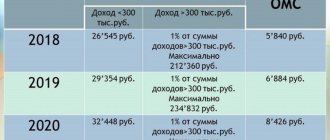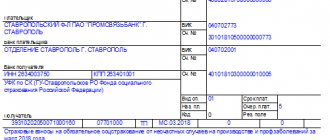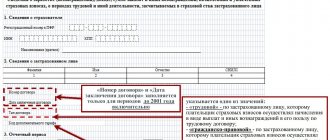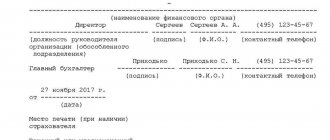New on contributions in 2018
Legislation in the field of insurance premiums is periodically adjusted, and officials of the Ministry of Finance and the Federal Tax Service interpret it in their own way. Here are some of the changes (actual and planned) and clarifications:
- From 01/01/2018, individual entrepreneurs’ contributions to the Pension Fund are not tied to the level of the minimum wage and are fixed in the form of fixed amounts for the coming years (2018–2020) in Art. 430 Tax Code of the Russian Federation:
- Officials of the Ministry of Finance in a letter dated 02.12.2018 No. 03-15-07/8369 (sent by a letter of the Federal Tax Service dated 02.21.2018 No. GD-4-11 / [email protected] ) prohibited individual entrepreneurs in special modes (STS, UTII and patent) from reducing expenses income received when calculating contributions. And only individual entrepreneurs on the general taxation system are allowed to do this. At the same time, the Federal Tax Service previously confirmed the possibility of simplifiers using the “income minus expenses” object to pay 1% to the Pension Fund of the Russian Federation on the difference between income and expenses (review of the legal positions of the Constitutional and Supreme Courts, approved by the Federal Tax Service of Russia on January 23, 2018).
- It is likely that soon policyholders will have to prepare reports on contributions (ERSV) on an updated form (at the time of writing, the draft order of the Federal Tax Service is at the stage of public discussion).
- It is planned that residents of TOP (advanced development territories) and residents of the free port of Vladivostok will be able to apply reduced rates on insurance premiums for 10 years from the period of acquiring such status.
The link to the bill is posted here.
Find out about tax innovations in our section.
Who pays insurance premiums 2020
Everyone who uses hired labor. These are organizations and individual entrepreneurs who hire employees under employment contracts. All of them are required to pay contributions for four types of compulsory insurance:
- pension;
- medical;
- social;
- from accidents at work.
If an employee was hired under a civil contract to perform some work or services, contributions must be made only for pension and health insurance. Other taxes are subject to agreement between the parties. If you have any doubts about whether insurance premiums have been drawn up correctly and exactly what deductions need to be paid for a specific employee, consult with specialists.
The employer makes all contributions at his own expense. It is illegal to shift the tax burden onto the employee, even if he agrees.
As you know, mandatory insurance premiums are charged on remuneration to individuals - employees, performers under civil partnership agreements, owners of exclusive rights, authors, etc. Accordingly, the obligation to calculate, charge and pay insurance premiums for 2020 rests with firms and entrepreneurs who act:
- employers,
- customers under GPC agreements with individuals,
- purchasers of licenses,
- buyers of exclusive rights, etc.
Organizations and individual entrepreneurs must pay insurance premiums at additional rates for pension insurance in 2020. However, not everyone needs to pay additional fees. Additional contributions are accrued only for payments to employees employed:
- in underground work, in work with hazardous working conditions and in hot shops (subclause 1, clause 1, article 30 of the Federal Law of December 28, 2013 No. 400-FZ, list No. 1, approved by Resolution of the Cabinet of Ministers of the USSR of January 26, 1991 No. 10 );
- on special types of work listed in subparagraphs 2–18 of paragraph 1 of Article 30 of the Federal Law of December 28, 2013 No. 400-FZ.
Insurance premium rates in 2020: rate table
If an individual entrepreneur or organization does not have the right to apply reduced tariff rates, then they must pay insurance premiums for medical, social and pension insurance at the basic tariff. As for the tariff rates for insurance premiums for 2020, they remained unchanged (based on No. 361-FZ of November 27, 2020). Only the maximum bases for calculating insurance premiums have changed (based on clauses 4-6 of Article 421 of the Tax Code of the Russian Federation, Decree of the Government of the Russian Federation of November 28, 2018 N 1426). You can familiarize yourself with them in the table below.
We add that in accordance with Articles 425-426 of the Tax Code of the Russian Federation, the general rate on insurance premiums is 30%. It will be valid until 2020 inclusive.
The distribution of the total bet is as follows:
- for social insurance – 2.9%;
- for pension insurance – 22%;
- for health insurance – 5.1%.
Table 1. Basic tariff rates for insurance premiums in 2020
| Health insurance | Social insurance (in case of temporary disability and in connection with maternity) | Pension insurance | ||
| Basic tariff | Basic tariff up to 912,000 rubles | Basic tariff over 912,000 rubles | Basic tariff up to 1,292,000 rubles | Basic tariff above 1,292,000 rubles |
| 5,1% (with the exception of HQS, stateless persons who temporarily reside on Russian territory) | 2,9% | 0 % | 22% | 10% |
| 1,8% (for foreign citizens and stateless persons who are temporarily staying on Russian territory (except for HQS)) | ||||
As already mentioned, some insurance premium payers are beneficiaries and have the right to make payments in accordance with reduced rates.
Let us remind you that in 2020 the preferential tariffs that were in force in 2020 are no longer valid for some categories of payers. These categories included individual entrepreneurs and organizations:
- who applied preferential treatment when working on the simplified tax system;
- pharmacies on UTII;
- who used PSN in the provision of services.
We present reduced insurance premium rates that are relevant in 2020 in the table below.
Table 2. Reduced tariff rates for insurance premiums in 2020
| Categories of insurers, eligible to reduced tariff rates | Health insurance % | Social insurance % | Pension insurance % |
| Organizations participating in the Skolkovo project | 0 | 0 | 14 |
| Charitable organizations on the simplified tax system | 0 | 0 | 20 |
| Non-profit organizations working on the simplified tax system in the areas of: education, social services for citizens, scientific research (development), art, healthcare, culture, mass sports (with the exception of professional). State and municipal institutions are not included in this list | 0 | 0 | 20 |
| Organizations and individual entrepreneurs with the status of residents of the free port of Vladivostok (based on No. 212-FZ of July 13, 2015) | 0,1 | 1,5 | 6 |
| Organizations and individual entrepreneurs with the status of residents of the territory of rapid socio-economic development (based on No. 473-FZ of December 29, 2014) | 0,1 | 1,5 | 6 |
| Organizations and individual entrepreneurs with payments and remunerations for the performance of labor duties to crew members of ships that are registered in the Russian International Register of Ships (with the exception of ships for storage and transshipment of oil and petroleum products in seaports of the Russian Federation) | 0 | 0 | 0 |
| Organizations of the Russian Federation working in the field of information technology (whose activities are related to the development, implementation of programs, as well as the installation, testing and maintenance of programs for databases, computers, and the provision of services for the development, adaptation, modification for databases, computers) | 4 | 2 | 8 |
| Organizations and individual entrepreneurs that have entered into agreements on the implementation of technology-innovation activities and making payments to employees employed in industrial-production and technology-innovation SEZs | 4 | 2 | 8 |
| Partnerships, as well as business entities that put into practice the results of intellectual activity, the exclusive rights to which belong to their participants (founders) - budgetary (autonomous) educational organizations of higher education and budgetary (autonomous) scientific institutions | 5,1 | 2,9 | 20 |
| Organizations and individual entrepreneurs that have entered into agreements on the implementation of tourism and recreational activities and make payments in favor of workers employed in tourist and recreational SEZs, which are united into a cluster by decision of the Russian government | 4 | 2 | 8 |
Employers must pay additional insurance premiums from the wages of employees who work in hazardous or hazardous conditions. Moreover, the rates of such contributions depend on the results of a special labor assessment (or the lack thereof). This is stated in paragraph 3 of Article 428 of the Tax Code of the Russian Federation.
In the table you can see additional tariffs for organizations and individual entrepreneurs when conducting a special labor assessment and in its absence for 2020
Table 3. Additional tariff rates for insurance premiums in 2020
| No special assessment was carried out | A special assessment was carried out (clause 3 of Article 428 of the Tax Code of the Russian Federation) | ||
| Contributions to pension insurance tariff (in%) | Payers of insurance premiums at an additional rate | Contributions to pension insurance tariff (in%) | Hazard class and subclass |
| 6,0 9,0 | Organizations and individual entrepreneurs making payments to employees working on jobs that are specified in paragraphs 2–18 of part 1 of Article 30 No. 400-FZ of December 28, 2013 Organizations and individual entrepreneurs making payments to employees working in jobs specified in paragraph 1 of part 1 of Article 30 No. 400-FZ dated December 28, 2013 (in accordance with List 1, which was approved by Resolution of the USSR Cabinet of Ministers No. 10 dated January 26, 1991 of the year) | 0,0 | class – optimal subclass – 1 |
| class - valid subclass – 2 | |||
| 2,0 | class - harmful subclass – 3.1 | ||
| 4,0 | class - harmful subclass – 3.2 | ||
| 6,0 | class - harmful subclass – 3.3 | ||
| 7,0 | class - harmful subclass – 3.4 | ||
| 8,0 | class - dangerous subclass – 4 | ||
Please note that if different additional tariffs for insurance premiums are allowed for payments in favor of one employee, then the highest value of the additional tariff must be applied.
Groups of insurance rates
The insurance premium rate is the rate established by law by which the insurer’s obligations are calculated. Each type of contribution has its own tariff.
Conventionally, insurance premium rates can be divided into 4 groups:
- percentage - set as a percentage of the insurance premium base (for example: 22%, 5.1%, etc.);
- total - indicated in fixed amounts without reference to the base of insurance premiums (for example, fixed contributions of individual entrepreneurs for themselves);
- combined - are a combination of a percentage rate and a sum rate (for example, the rate of contributions for individual entrepreneurs for themselves with an income of more than 300,000 rubles).
Next, we will dwell in more detail on the insurance premium rates for 2018.
Insurance premiums 2019: what is important to know
The legislation establishes 4 types of payments to extra-budgetary funds:
- For compulsory pension insurance,
- For compulsory health insurance,
- For compulsory social insurance in case of disability and maternity,
- For social insurance against accidents at work and occupational diseases.
Who makes the payments:
- Organizations – employers, customers under GPC agreements, buyers of licenses and exclusive rights;
- Entrepreneurs – employers, customers under GPC agreements, buyers of licenses and exclusive rights.
Entrepreneurs who do not employ hired workers pay contributions “for themselves.”
What determines the size of the tariff? It is influenced by 3 indicators:
- Employer category, since some groups of employers can use reduced tariffs, and some, on the contrary, are required to pay additionally,
- Category of workers, since higher rates are established for some groups of workers,
- The amount of payments to the employee, because the law sets limits, if exceeded, the rates are reduced.
The number of working days in 2020 does not matter.
When and where to submit insurance premium payments
RSV - quarterly report to the tax office. Submit your payment no later than the 30th day of the month following the reporting period. The reporting periods for insurance premiums are quarterly, half-yearly, nine months and calendar year. The calculation we submit includes indicators from the beginning of the year to the end of the reporting quarter. That is, the DAM for the second quarter includes data for six months, and for the third quarter - data for 9 months of 2020. The deadlines for submitting the calculation are as follows:
- 1st quarter - April 30, 2020;
- 2nd quarter (half year) - July 30, 2020;
- 3rd quarter (9 months) – October 30, 2020;
- for the 4th quarter (2020) - February 1, 2021.
If the delivery day falls on a weekend or holiday, the due date is postponed to the next closest working day.
The day on which you submitted the report to the tax inspector and received the acceptance stamp on the second copy is considered the day the calculation is submitted. When sent by mail, the day the post office accepted the package and stamped it. When sending by telecommunications - the day on which your TCS operator recorded the sending of the calculation.
Individual entrepreneurs submit their calculations to the tax office at their place of residence. Organizations and separate divisions that pay salaries to employees or performers report at their location.
Taxable base and limits on insurance premiums in 2020
Limits on the annual amount of remuneration for individual contributions were established for the first time in 2011. They are approved by the Government of the Russian Federation for each coming year. The meaning of these limits is that contributions at regular rates are calculated differently depending on whether the amount of payments to an individual for savings since the beginning of the year has exceeded the limit.
So far, the limits are increasing every year. And until 2020. limits were approved not only for contributions to compulsory health insurance and contributions to compulsory health insurance for sick leave and maternity leave, but also for payments to compulsory medical insurance. Now the limits on annual payments for medical contributions have been abolished. Read more about restrictions on remuneration for individuals in Table 1.
Table 1. Income limits for insurance premiums in 2019
| Year | Limit on annual payments | ||
| on OPS | on OSS | on compulsory medical insurance | |
| 2019 | 1,150,000 rub. | 865,000 rub. | — |
| 2018 | 1,021,000 rub. | 815,000 rub. | — |
| 2017 | 876,000 rub. | 755,000 rub. | — |
| 2016 | 796,000 rub. | 718,000 rub. | — |
| 2015 | 711,000 rub. | 670,000 rub. | — |
| 2014 | 624,000 rub. | 624,000 rub. | 624,000 rub. |
| 2013 | 568,000 rub. | 568,000 rub. | 568,000 rub. |
| 2012 | 512,000 rub. | 512,000 rub. | 512,000 rub. |
| 2011 | 463,000 rub. | 463,000 rub. | 463,000 rub. |
| Type of insurance premiums | The size of the maximum base in 2020 |
| Contributions for compulsory health insurance | Have no limit base |
| Contributions to compulsory social insurance | 865,000 rubles |
| Contributions to compulsory pension insurance | 1,150,000 rubles |
Insurance contributions for pension insurance of Sviridov A.P. in 2020
| Month of 2020 | Growing base of insurance contributions for pension insurance from the beginning of 2020 (in rubles) | The amount of insurance premiums that were accrued (in rubles) | ||
| Up to 1,021,000 rubles | Over 1,021,000 rubles | At a rate of 22% | At a rate of 10% | |
| January | 95 000 | 20 900 | ||
| February | 190 000 | 20 900 | ||
| March | 285 000 | 20 900 | ||
| April | 380 000 | 20 900 | ||
| May | 475 000 | 20 900 | ||
| June | 570 000 | 20 900 | ||
| July | 665 000 | 20 900 | ||
| August | 760 000 | 20 900 | ||
| September | 855 000 | 20 900 | ||
| October | 950 000 | 20 900 | ||
| November | 1 021 000 | 24 000 | 15 620 | 2 400 |
| December | 1 140 000 | 9 500 | ||
Insurance contributions for social insurance for temporary disability and in connection with maternity Sviridova A.P. in 2018
We calculate social insurance contributions in 2018 at a rate of 2.9% (for temporary disability and in connection with maternity). The limit set for social insurance contributions is 815,000 rubles. If this amount is exceeded, insurance premiums are no longer charged.
Let's see what insurance premiums will look like for Sviridov with a salary of 95,000 rubles in 2020:
| Month of 2020 | Growing base of social insurance contributions from the beginning of 2020 (rub.) | The amount of insurance premiums that were accrued at a rate of 2.9% in 2018 (rub.) |
| January | 95 000 | 2 755 |
| February | 190 000 | 2 755 |
| March | 285 000 | 2 755 |
| April | 380 000 | 2 755 |
| May | 475 000 | 2 755 |
| June | 570 000 | 2 755 |
| July | 665 000 | 2 755 |
| August | 760 000 | 2 755 |
| September | 815000 | 1595 |
| October | 815000 | 0 |
| November | 815000 | 0 |
| December | 815000 | 0 |
Since September 2020, the employee’s insurance premiums have exceeded the established limit of 815,000 rubles, which means that from October there is no longer a need to accrue contributions for temporary disability and in connection with maternity.
Insurance premiums for “injuries” of Sviridov A.P. in 2018
Let us remind you that in order to calculate insurance premiums for “injuries” in 2018, the occupational risk classes of the main type of activity of the enterprise should be taken into account.
There is no maximum base for calculating this type of insurance premiums.
For the organization where Sviridov works, the risk class is 0.2%. Let's calculate how much you need to pay each month:
95,000 * 0.2% = 190 rubles.
That is, for the year you will need to pay 190 * 12 = 2,280 rubles.
Contribution rates according to Law No. 125-FZ
According to the law on compulsory insurance against industrial accidents and occupational diseases dated July 24, 1998 No. 125-FZ, contributions “for injuries” are paid.
These are mandatory payments transferred by policyholders to the Social Insurance Fund. Of these, individuals are paid compensation for harm to health (received while performing work duties).
This type of insurance premium (unlike those listed above) is not controlled by the tax authorities. They are supervised by social insurance.
The difference between this type of contribution and other mandatory insurance premiums lies in the special technology for determining them (individual approach).
The rates of insurance premiums for 2020 “for injuries” can be found in Art. 1 of the Law of December 22, 2005 No. 179-FZ. The fact that they are still relevant in 2020 is stated in Art. 1 of the Law of December 31, 2017 No. 484-FZ.
In 2020 (as in previous years), there are 32 contribution rates “for injuries” - a separate rate for each class of professional risk.
The rate of contributions “for injuries” differs from other insurance premiums in the specific way they are established:
- for each policyholder, tariffs are set annually by social insurance specialists;
- their value depends on the occupational risk class of the organization’s main activity;
- the main type of activity must be confirmed by submitting to the Social Insurance Fund (annually no later than April 15) a package of documents (application for confirmation of the main type of activity, a confirmation certificate and a copy of the explanations to the balance sheet);
- in the absence of this package of documents, the fund’s specialists will independently set the contribution rate based on the type of activity with the highest class of professional risk.
Let's look at an example of how the rate of contributions “for injuries” depends on the presence/absence of confirmation of the main type of activity.
How to save on your tariff?
There are few legal ways, but they exist.
For example, you can conclude with a potential employee not an employment contract, but a student agreement. Scholarships under a student agreement are not subject to insurance contributions.
Article 422 lists payments that are not subject to insurance contributions. Part of an employee's salary can be replaced with these payments. Thus, financial assistance up to 4 thousand rubles per year, financial assistance for the birth and adoption of a child up to 50 thousand rubles per child, daily allowance in any amount and compensation for travel expenses, etc. are not taxed.
If you use the services of individuals under civil contracts, in addition to personal income tax, you must pay 22% of pension contributions and 5.1% of medical contributions from the remuneration under this contract. Look for a person who provides the same services, but is registered as an individual entrepreneur. Enter into an agreement with him as an individual entrepreneur, and then he will pay taxes and contributions for himself.
Three months of accounting, HR and legal support FREE. Hurry up to apply, the offer is limited.
See how timely confirmation of the company’s main activity affects the rate.
Example 1
* The specialists of StroyProekt LLC took the occupational risk class from the appendix to the Order of the Ministry of Labor dated December 30, 2016 No. 851n.
** The rate of contributions “for injuries” is indicated in accordance with Art. 1 of the Law of December 22, 2005 No. 179-FZ.
Conclusion: the main activity of StroyProekt LLC is construction design - OKVED 41.10 (largest share of revenue: 31.24%). The insurance premium rate is 0.2.
No later than 04/16/2018 (rescheduled from Sunday, 04/15/2018), StroyProekt LLC should send the necessary papers to the FSS to confirm the main type of activity.
Find out how the Social Insurance Fund feels about postponing reporting deadlines from the publication.
Example 2
Let's change the conditions of example 1: StroyProekt LLC did not confirm the main type of activity.
As a result, the fund’s specialists independently established the insurance premium rate “for injuries” for StroyProekt LLC, choosing the maximum rate - 1.2.
Conclusion: the absence in the Social Insurance Fund of documents confirming the main activity of StroyProekt LLC has led to a situation where the company will have to pay contributions in an amount 6 times higher than the “confirmed” tariff.
New RSV form from April 1, 2020
The calculation form for insurance premiums in 2020 was updated by order of the Federal Tax Service of the Russian Federation dated September 18, 2019 No. ММВ-7-11 / [email protected] The form has a KND number - 1151111. Detailed instructions for filling out the DAM are in Appendix No. 2 to the order. Filling out the form will require accuracy and attention, since errors in the calculation can lead to fines and the need to re-submit the DAM.
The main changes in the calculation affected the design of the form. It has become simpler and reduced by almost 1/3. Let's look at the innovations in more detail:
- Title page. Fields have appeared for information about separate divisions that were closed or deprived of authority.
- The sheet with data for citizens without a registered individual entrepreneur has been removed. Now they submit reports according to the same rules as entrepreneurs.
- The “Payer type” field has been added to section 1 Those who made payments to individuals during the last quarter put “1”, those who did not make payments put “2”. The lines for calculating the total amounts of contributions payable have been removed. Instead of subsection 1.4, Appendix No. 1.1 was added to the first section.
- In Appendix 2, the field “Payer Tariff Code” and the line “Number of individuals from whose payments insurance premiums were calculated” were added.
- In subsections 1.1 and 1.2, lines have been added for deductions under copyright agreements or intellectual property agreements.
- In subsection 1.3.2 it is no longer necessary to indicate the code of the reasons for filling out the calculation. The danger of workplaces is classified based on the results of a special assessment.
- In Appendix 1 to Section 2, farmers are required to indicate the identification code and data from it. If a peasant farm has several chapters, then information is entered for each.
- In section 3 , field 010 was added with a sign of cancellation of information about the insured. It is filled out when an employee’s personal data needs to be cancelled.
Tariffs for entrepreneurs
Individual entrepreneurs calculate and pay contributions according to two schemes:
- as employers (calculating insurance premiums from the income of their employees);
- for yourself (regardless of whether the individual entrepreneur has employees or not).
At the same time, the individual entrepreneur pays contributions to compulsory health insurance and contributions to health insurance for himself. This concludes the mandatory part for insurance premiums for individual entrepreneurs. But there remains the possibility of voluntarily paying contributions as part of insurance in the event of disability or in connection with maternity. When paying such contributions, the entrepreneur has the right to receive benefits upon the occurrence of an insured event (illness or childbirth).
Find out more about insurance premium rates for 2020 for individual entrepreneurs in the next section.











